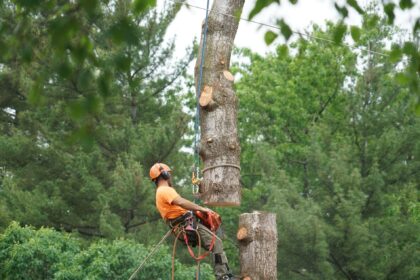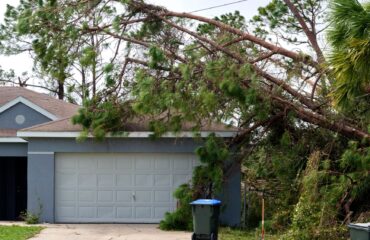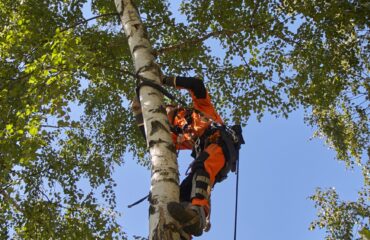
The Role of Professionals in Safe and Efficient Tree Removal
Understanding what a professional tree removal offers is key for homeowners and property managers who are considering tree removal in an effort to keep their landscapes safe, attractive, and ecologically balanced. Tree removal is a complex process that requires precise timing, the correct approach, a focus on safety, and consideration for the environmental repercussions.
Archer Tree Services offers an in-depth guide delving into the complexities of tree removal, aiding in the decision of whether to undertake it as a DIY project or opt for professional tree removal services. This guide covers various removal techniques, highlights the necessity of professional expertise, addresses environmental concerns, evaluates risks, and offers guidance to property owners. It is designed to aid them in making well-informed choices about when a tree needs to be removed and when it might be spared, all with the aim of preserving the health of their landscape and the broader ecosystem.
Opting for Archer Tree Services means entrusting your tree removal needs to specialists who prioritize safety above all. Our team performs comprehensive risk assessments to ensure the use of the safest removal methods, thereby reducing any potential damage to your property and its surroundings. Equipped with state-of-the-art machinery and employing sophisticated techniques, we deliver an all-encompassing professional tree removal service that includes everything from the actual removal to stump grinding and site clearance, ensuring your landscape is left in impeccable condition. With our expertise and meticulous approach, your project will be handled with the utmost precision and care from beginning to end.
Understanding the Signs for Professional Tree Removal
Regular tree care is crucial not only for the health and aesthetics of your landscape but also for ensuring safety and preventing potential hazards. To help you determine when it might be time to call in the professionals, here are some important indicators that suggest professional tree removal may be necessary:
- Dead or Dying Branches: Large, lifeless branches not only mar the beauty of a landscape but also pose a considerable risk to property and personal safety, especially during stormy weather or high winds. These branches may break off, potentially causing damage or injury.
- Leaning Trees: Although a minor natural lean is typical, a sudden or significant tilt may indicate root damage or soil erosion. This compromises the tree’s stability and elevates the risk of it falling.
- Visible cracks or cavities: This can indicate that the tree’s structural integrity is compromised, increasing its vulnerability to breakage. These defects often indicate a decline in tree health and elevate the risk of collapse.
- Fungal Presence: The appearance of mushrooms or fungi at the base of a tree or on its trunk typically signals internal decay. These organisms thrive on decomposing organic matter, suggesting that the tree may be suffering from internal rot.
Monitoring these indicators and taking timely action can avert property damage and injuries. In case of uncertainty, consulting a professional for an evaluation of your trees’ health and stability is advisable.
Why Prompt, Professional Tree Removal is Key
Removing a tree is unequivocally a task for professionals, not a DIY endeavor. The dangers of forgoing professional tree removal services are substantial and varied, encompassing the risk of death, serious injuries, significant property damage, and potential legal issues due to non-adherence to local regulations and safety standards. Given these risks, it is imperative to hire professionals who possess the requisite knowledge, experience, and equipment. This approach is not merely recommended; it is crucial for ensuring safety and compliance.
Safety Concerns
Annually in the United States, around 100 fatalities occur due to accidents related to tree falls and landscaping, underscoring the need for professional tree removal services. The main factors contributing to the high-risk nature of these tasks include:
- Electrocution hazards: The proximity to power lines during operations significantly elevates the risk of electrocution.
- Unpredictable tree movement: Trees can move unexpectedly due to internal decay or external forces like wind, posing serious risks.
- Risk of falling branches: The danger of branches falling can cause severe injuries or even fatalities.
Given these considerations, it is evident that tree removal and related activities are highly hazardous and should be carried out exclusively by experienced professionals. These experts possess the necessary safety equipment, such as helmets, gloves, and harnesses, and have the requisite knowledge and training to safely overcome the challenges posed by the job.
Costs and Risks of Delaying Removal
Postponing the removal of a deceased or decaying tree escalates the risk of damage to property and the likelihood of personal injury. Consider the following critical points:
- Elevated Damage Risk: A compromised tree represents a significant hazard to structures, vehicles, and nearby areas, particularly under severe weather conditions.
- Hazard to Personal Safety: Falling trees or branches have the potential to inflict severe injuries on individuals nearby.
- Increased Emergency Removal Costs: The expense associated with emergency professional tree removal services necessitated by a storm or unexpected collapse typically surpasses that of pre-planned removals.
Addressing the issue of a dead or dying tree without delay is crucial. Proactive removal is not only a safety measure but also a cost-effective strategy, mitigating the elevated expenses and dangers linked to emergency scenarios.
Approaches to Tree Removal Based on Location and Conditions
Tree removal is a complex process, determined by factors like the tree’s exact location, size, and the characteristics of the surrounding area. Specialists in this field employ various proven strategies to ensure trees are removed safely and efficiently. These techniques are chosen based on a thorough assessment of each specific situation, with the goal of ensuring the safety of all individuals involved and the protection of nearby properties.
- Traditional Felling: The preferred method for removing trees involves making a precise cut at the base to guide the direction in which the tree falls. While it is efficient and cost-effective, this technique necessitates ample open space, rendering it less suitable for urban or densely populated areas.
- Sectional Dismantling: Ideal for constrained spaces or when nearby structures present a risk, sectional dismantling is the method of choice. Professionals ascend the tree, systematically segmenting it and carefully lowering each section via ropes. This technique ensures minimal impact on the environment, albeit being more time-consuming and demanding in terms of labor.
- Crane-Assisted Tree Removal: For oversized trees or those situated in difficult-to-access areas, opting for crane-assisted removal offers a safe and efficient solution. Utilizing a crane to hoist sections of the tree post-cutting enables swift extraction while significantly reducing the properties. This risk of damage to surrounding method is particularly advantageous for trees that are too fragile for conventional removal techniques.
The Role of Risk Assessment in Professional Tree Removal
Our seasoned team conducts an in-depth risk assessment to identify the safest and most efficient approach to professional tree removal, considering the tree’s condition, structural stability, and relevant environmental factors. This crucial measure is vital to avoid property damage and safeguard residents’ well-being.
The risk assessment procedure involves a thorough review of essential factors to guarantee the safe and effective removal of trees. Experts meticulously evaluate the following aspects:
- Tree Health Evaluation: Arborists start a professional tree removal service with a comprehensive assessment of the tree’s health, searching for signs of disease, decay, or pest infestation. They scrutinize the bark, leaves, and structural integrity for any distress signals, such as cracks, cavities, or fungal growth, indicating potential issues.
- Structural Stability: Assessing the stability of a tree is crucial for evaluating its risk of failure. This requires a thorough examination of the tree’s roots, trunk, and branches for any indications of instability. Special consideration is given to trees that lean, as they present an increased danger of toppling, particularly during severe weather conditions.
- Environmental Considerations: The evaluation meticulously examines the tree’s surroundings to pinpoint potential challenges or hazards. This encompasses its proximity to structures, power lines, or other critical infrastructure that might be jeopardized during removal. Furthermore, it assesses the possible impact on the local ecosystem, including habitat disruption or soil erosion, ensuring a comprehensive understanding of environmental implications.
- Tree Size and Location: Conducting a detailed analysis of the tree’s dimensions, such as its height, canopy breadth, and root extension, alongside its placement, is pivotal in selecting the optimal removal method. Techniques vary from conventional felling to precise sectional dismantling or the employment of cranes.
- Risk of Displacing Wildlife: The assessment takes into account the tree’s role as a habitat or food source for wildlife. Identifying nests, dens, or signs of feeding could necessitate timing the removal to minimize effects on local wildlife populations.
- Safety of the Public and Properties: The most important part of a professional tree removal service is ensuring the safety of both the public and surrounding properties. This assessment evaluates potential risks to people and neighboring properties, determining whether protective actions or temporary relocations are needed during the removal process.
Our thorough assessment ensures that our professional tree removal service is conducted with the utmost care for the safety of people, property, and the environment, maintaining a balance between human needs and ecological preservation.
Archer Tree Services: Your Partner in Safe Tree Removal
Professional tree removal is a meticulous process that emphasizes safety, compliance with regulations, and the preservation of the environment. It requires careful planning to evaluate the tree’s health, its location, and the potential effects on its surroundings. The approach involves choosing the appropriate equipment and methods to limit damage to adjacent structures and flora. Moreover, it takes into account legal stipulations to avert fines and ensures that the removal procedures bolster local wildlife diversity and soil integrity.
At Archer Tree Services, we excel in executing swift and effective professional tree removals, safeguarding your property, and elevating its aesthetic appeal. Recognizing the urgency and hazards linked to compromised trees, we offer tailored services to meet the specific demands of each case. Catering to residential and commercial property owners within a 30-mile radius of Sandersville, GA, our pride lies in our vast experience, superior equipment, and unwavering commitment to customer satisfaction.
Whether you’re addressing an obstructive tree, storm aftermath, or worries regarding a diseased or decaying tree, we are here to assist. Our team is prepared to provide a complimentary estimate and address any inquiries to guarantee your property not only looks fantastic but is also secure for all.
Choosing Archer Tree Services means partnering with a company that possesses the necessary expertise and experience to overcome any tree removal challenge, all while ensuring the safety of your property and community. Reach out to us today for your tree removal requirements. Allow us to manage your trees so you can relish a beautiful and hazard-free environment.



